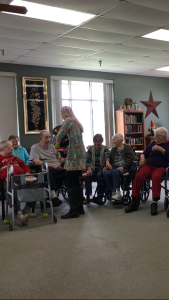 Have you ever been in a situation where you wake up at three in the morning and an idea comes to you that’s so obvious, so simple, that you can’t believe it didn’t occur to you before.
Have you ever been in a situation where you wake up at three in the morning and an idea comes to you that’s so obvious, so simple, that you can’t believe it didn’t occur to you before.
This happened to me with group drum therapy. As a person that visits a lot of nursing homes and assisted living homes to perform this kind of activity, I assumed that you needed all of the correct experience and knowledge in order to do it.
But what I found was that I had a better experience when the therapist or other attendant was walking around helping me out. It occurred to me that in order to get the best, most therapeutic, and most fun results for the residents, the therapists or attendants needed to be involved.
They’re the experts. They have the knowledge of and the relationships and rapport with  the residents. More than that – they can do this every day, if they want.
the residents. More than that – they can do this every day, if they want.
I know they probably wouldn’t, but a lot of the value comes from frequency – as you do it more, the participants get more comfortable with the idea and become more creative – and more active! There’s a better chance that they’ll remember what you did the time before. There is a lot of value in making this a regular part of your routine.
So why do I need to be there? I know that people respond better to a new face and somebody that they can associate with only that activity. The reality is, though, that I can only get to a certain facility every month or so and that’s all they can afford!
It’s really just a matter of having the tools. If members of the staff or volunteers know how to perform the sessions, they can do this all of the time and have an effective way not only for the residents to enjoy themselves but also to stimulate physical, mental, and social activities.
They don’t need to understand music theory and have the ability to play a song on the guitar! Don’t get me wrong – there’s value in that and I have a great deal of respect for the therapists that do that. They don’t have to, though. Don’t let the perfect be the enemy of the good. There is tremendous value in group drumming and it is not the same thing as music therapy.
Group drumming (e.g. a drum circle) is a scientifically proven but underutilized therapy and a very effective way to play games, review trivia, and do just about anything else you want – and creating the instruments, decorating, and personalizing them, can be a separate activity that can be repeated, all in itself!
 The best part, though, is that it’s free (once someone is trained). When your volunteers conduct the activity, the residence will get as much if not more out of each session and it’s an easy enrichment activity to do when nothing else is booked or planned!
The best part, though, is that it’s free (once someone is trained). When your volunteers conduct the activity, the residence will get as much if not more out of each session and it’s an easy enrichment activity to do when nothing else is booked or planned!
At a time when budgets are tight and money is shifted away from activities and enrichment, this is a great way to raise the quality of life of residence while saving money.
If you’re interested in leading drum therapy at your facility – this will get you started: http://beatmydisease.com/bmd-drum-circle-1/

Enjoyed this article. I have considered drum therapy for my dementia/memory support unit. Please tell me how I can learn or be trainied to lead this. Thanks
I’m glad you liked it, Julie! I put a bunch of resources and videos together – this should get you started: http://beatmydisease.com/rocket-rehab-intro/